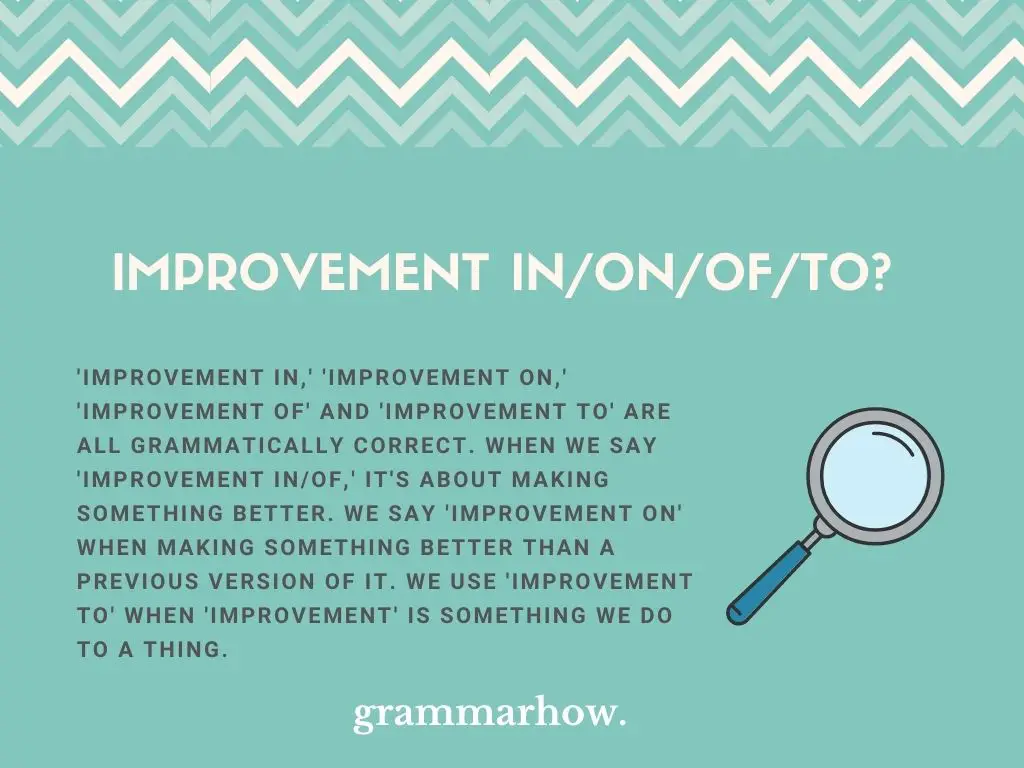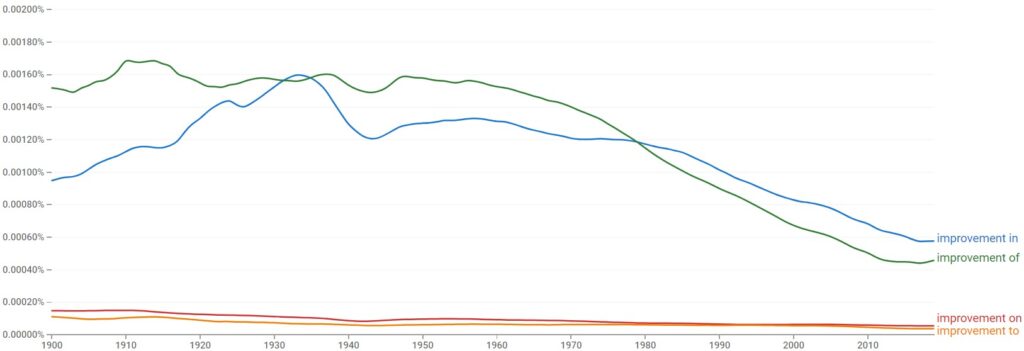Prepositions can make a big difference in the meanings of your sentence. While many think prepositions don’t matter, whether you’re using ‘in,’ ‘on,’ ‘of,’ or ‘to’ can change what you’re implying. So, the ‘improvement of,’ ‘improvement in,’ ‘improvement to,’ and ‘improvement on’ are totally different! Let’s see how!
Is It ‘Improvement In,’ ‘Improvement On,’ ‘Improvement Of,’ or ‘Improvement To?’
‘Improvement in,’ ‘improvement on,’ ‘improvement of’ and ‘improvement to’ are all grammatically correct. When we say ‘improvement in/of,’ it’s about making something better. We say ‘improvement on’ when making something better than a previous version of it. We use ‘improvement to’ when ‘improvement’ is something we do to a thing.

Let’s talk about ‘improvement in’ and ‘improvement of.’ When there is an improvement in something, it means that something becomes better. For example, ‘There have been drastic improvements in medical technologies in the past decades.’
When we say ‘improvement of,’ it also means something becoming better. However, we mainly use this when talking about improvement in prospects. For example, ‘We anticipate the improvement of local public schools in the country.’ However, between ‘in’ and ‘of,’ the use of ‘improvement in’ is generally more recognized and accepted.
We use ‘improvement on’ when talking about improvements in comparison to a previous thing or situation. We use this when there’s a reference as to how or in what way something has improved compared to how it was before. For example, ‘The new car models are an improvement on the faulty old ones.’
‘Improvement to’ is a special case. Unlike the previous phrases where we use ‘improvement’ as a noun, ‘improvement to’ uses ‘improvement’ as a direct object. The complete phrase usually goes ‘make improvements to [something].’ The meaning follows that making improvements to something means making something better.
Given that the phrases have similarities in meaning, generally, they are interchangeable with each other, but there is still a more appropriate phrase for every situation or context. It’s best to check by ear which sounds most appropriate to put in a sentence. ‘Improvement to’ and ‘improvement in’ are the most common and flexible phrases that are almost, if not, always applicable in any context.
Improvement In
When there is an ‘improvement in [something],’ it means that something is made better. ‘Improvement in’ in a way implies an upgrade of an existing thing or situation. It’s comparable to a standard becoming premium, or an A becoming an A-plus. The phrase applies to almost any context.
Take a look at this example below.
- The recent trends in our graph show an improvement in our sales.
In the sentence above, ‘improvement in’ implies that there is an upgrade in the sales or that the sales of the company are now looking better.
Below are more examples of how to use ‘improvement in’ in a sentence.
- I don’t see any improvement in our performances despite practicing.
- There has been an improvement in our school’s internal system in the past years.
- The continuous improvement in automobile technologies has made our lives more convenient.
- I see lots of improvement in your dancing skills.
- Are there any improvements in your patients’ condition?
- The students failed to make any improvements in their research papers.
- Our coach applauded Maria’s improvements in her vocal skills.
Improvement On
We use ‘improvement on’ when we say something is better compared to a previous version of that thing or situation. Saying A is an improvement on B implies that A is better or is much more of an upgrade compared to B.
Take a look at the example below.
- The newly elected leader is an improvement on last year’s head.
In the sentence above, ‘improvement on’ implies that the new leader is better or is an improvement compared to the previous leader.
Below are more examples of how to use ‘improvement on’ in a sentence.
- The new phone model is an improvement on last year’s model.
- Your work this semester is an improvement on your work last semester.
- You are definitely an improvement on the previous marketing head.
- The new logistics team is an improvement on the logistics team we had for the previous project.
- I think this is a lot of improvement on last year’s exhibit.
- I don’t see any new improvements on last term’s sales.
- Does the current model have any improvements on the previous model?
Improvement Of
We use ‘improvement of’ when we talk about making something better. It is similar to ‘improvement in.’ However, we mostly use ‘improvement of’ when talking about the improvement in prospect, something that is anticipated but has not yet happened. ‘Improvement of’ is also less used compared to ‘improvement in.’
Take a look at the example below.
- The new committee is meeting about the improvement of local school systems.
In the sentence above, ‘improvement of’ implies that the local school systems are to be made better in prospect. However, it means that the improvement has not happened yet.
Below are examples of how to use ‘improvement of’ in a sentence.
- We look forward to the continuous improvement of our team.
- Let’s work together for the improvement of our services.
- The improvement of our schools should be our top priority.
- The improvement of our business is our goal in all our endeavors.
- We are talking about action steps for the improvement of our system.
- Our leader said we need to talk about the improvement of our upholding of environmental responsibilities.
- We will continue to strive for the improvement of our products.
Improvement To
‘Improvement to’ is a phrase that uses ‘improvement’ as a direct object. The complete phrase goes ‘make improvement/s to [something]’ which means or implies making something better. For example, ‘make improvements to the food’ essentially means making the food taste better.
The main difference between ‘improvement to’ and ‘improvement in/on/of’ is that, ‘improvement to’ takes ‘improvement’ mostly as a direct object rather than a noun. ‘Improvement’ becomes the receiver of the verb ‘make.’ However, the meaning still implies that to make improvements on something is to make it better.
Below are examples of how to use ‘improvement to’ in a sentence.
- I think we still need to make improvements to the current model.
- Did we make any improvements to the old products?
- Make improvements to the performance you choreographed.
- We made improvements to our services, but it is still not noticeable.
- I don’t think you made any improvements to your marketing strategies.
- The team will make improvements to the branding of our products.
- Newly hired engineers will focus on making improvements to the current car models.
Which Preposition Is Used The Most?
According to the Google Ngram Viewer, ‘in’ is used the most and is followed shortly by ‘of.’ There is quite a gap between ‘of’ and ‘on,’ while ‘to’ follows right after ‘on.’ It is probably because ‘in’ and ‘of’ are more general, while ‘on’ and ‘to’ are specific.

‘In’ and ‘of’ can be used in various and almost any context, while ‘on’ is more specific to comparing to a previous version, and ‘to’ is more specific for ‘improvement’ as a direct object.

Martin holds a Master’s degree in Finance and International Business. He has six years of experience in professional communication with clients, executives, and colleagues. Furthermore, he has teaching experience from Aarhus University. Martin has been featured as an expert in communication and teaching on Forbes and Shopify. Read more about Martin here.
